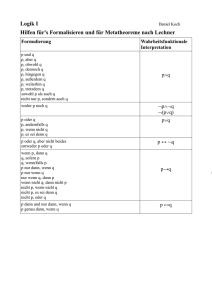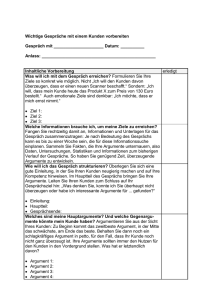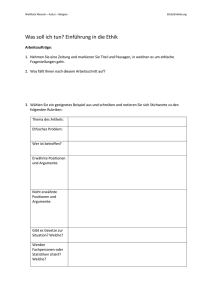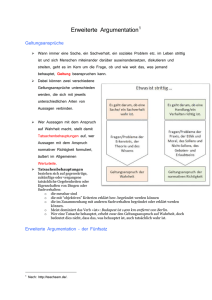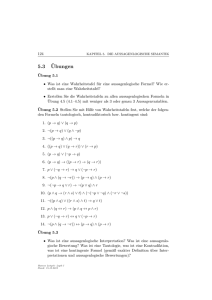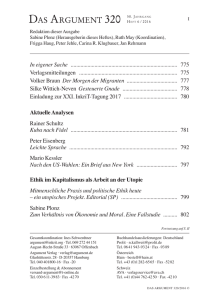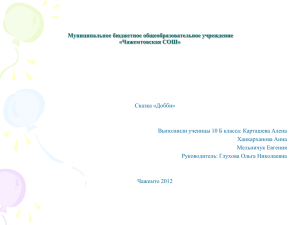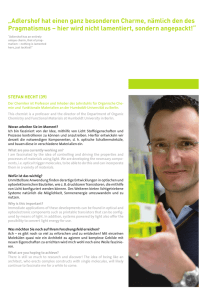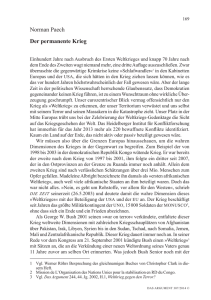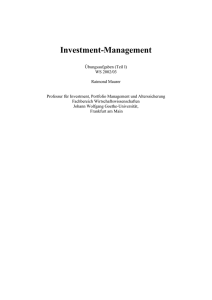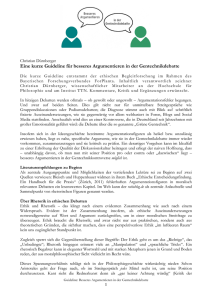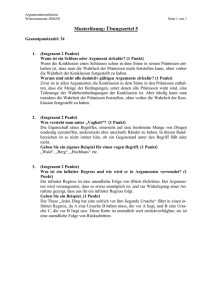Argument Structure in Nominalizations: The Case of the Light Verb
Werbung
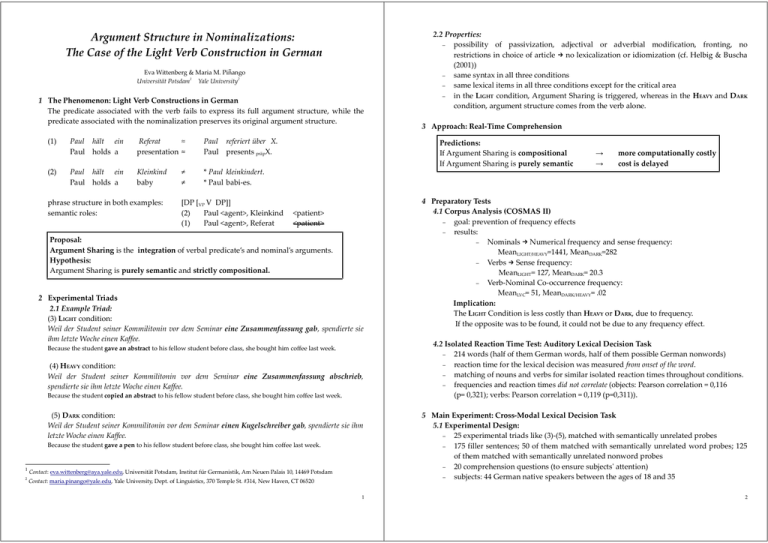
Argument Structure in Nominalizations: The Case of the Light Verb Construction in German Eva Wittenberg & Maria M. Pinango Universität Potsdam1 Yale University2 1 The Phenomenon: Light Verb Constructions in German The predicate associated with the verb fails to express its full argument structure, while the predicate associated with the nominalization preserves its original argument structure. (1) (2) Paul hält ein Paul holds a Referat ≈ presentation ≈ Paul referiert über X. Paul presents präpX. Paul hält ein Paul holds a Kleinkind baby * Paul kleinkindert. * Paul babi-es. phrase structure in both examples: semantic roles: ≠ ≠ [DP [VP V DP]] (2) Paul <agent>, Kleinkind (1) Paul <agent>, Referat <patient> <patient> 2 Experimental Triads 2.1 Example Triad: (3) LIGHT condition: Weil der Student seiner Kommilitonin vor dem Seminar eine Zusammenfassung gab, spendierte sie ihm letzte Woche einen Kaffee. Because the student gave an abstract to his fellow student before class, she bought him coffee last week. (4) HEAVY condition: Weil der Student seiner Kommilitonin vor dem Seminar eine Zusammenfassung abschrieb, spendierte sie ihm letzte Woche einen Kaffee. Because the student copied an abstract to his fellow student before class, she bought him coffee last week. (5) DARK condition: Weil der Student seiner Kommilitonin vor dem Seminar einen Kugelschreiber gab, spendierte sie ihm letzte Woche einen Kaffee. Because the student gave a pen to his fellow student before class, she bought him coffee last week. 2 3 Approach: Real-Time Comprehension Predictions: If Argument Sharing is compositional If Argument Sharing is purely semantic Proposal: Argument Sharing is the integration of verbal predicate’s and nominal’s arguments. Hypothesis: Argument Sharing is purely semantic and strictly compositional. 1 2.2 Properties: ‒ possibility of passivization, adjectival or adverbial modification, fronting, no restrictions in choice of article → no lexicalization or idiomization (cf. Helbig & Buscha (2001)) ‒ same syntax in all three conditions ‒ same lexical items in all three conditions except for the critical area ‒ in the LIGHT condition, Argument Sharing is triggered, whereas in the HEAVY and DARK condition, argument structure comes from the verb alone. Contact: [email protected], Universität Potsdam, Institut für Germanistik, Am Neuen Palais 10, 14469 Potsdam Contact: [email protected], Yale University, Dept. of Linguistics, 370 Temple St. #314, New Haven, CT 06520 1 → → more computationally costly cost is delayed 4 Preparatory Tests 4.1 Corpus Analysis (COSMAS II) – goal: prevention of frequency effects – results: – Nominals → Numerical frequency and sense frequency: MeanLIGHT/HEAVY=1441, MeanDARK=282 – Verbs → Sense frequency: MeanLIGHT= 127, MeanDARK= 20.3 – Verb-Nominal Co-occurrence frequency: MeanLVC= 51, MeanDARK/HEAVY= .02 Implication: The LIGHT Condition is less costly than HEAVY or DARK, due to frequency. If the opposite was to be found, it could not be due to any frequency effect. 4.2 Isolated Reaction Time Test: Auditory Lexical Decision Task – 214 words (half of them German words, half of them possible German nonwords) – reaction time for the lexical decision was measured from onset of the word. – matching of nouns and verbs for similar isolated reaction times throughout conditions. – frequencies and reaction times did not correlate (objects: Pearson correlation = 0,116 (p= 0,321); verbs: Pearson correlation = 0,119 (p=0,311)). 5 Main Experiment: Cross-Modal Lexical Decision Task 5.1 Experimental Design: – 25 experimental triads like (3)-(5), matched with semantically unrelated probes – 175 filler sentences; 50 of them matched with semantically unrelated word probes; 125 of them matched with semantically unrelated nonword probes – 20 comprehension questions (to ensure subjects' attention) – subjects: 44 German native speakers between the ages of 18 and 35 2 – – two semi-randomized scripts; six experimental lists of probe-condition matching to avoid any priming effects Probing Comprehension: Licensing Position (°): where argument sharing is triggered. LC+300 Position (°°): where argument sharing is predicted to be fully implemented. Example: Weil der Student seiner Kommilitonin vor dem Seminar… …eine Zusammenfassung gab ° spendierte sie ihm°°… …eine Zusammenfassung abschrieb ° spendierte sie ihm°°… …einen Kugelschreiber gab ° spendierte sie ihm°°… …letzte Woche einen Kaffee. 7 Conclusions: Composite argument structure in light verb constructions results from a compositional process: Argument Sharing. Argument Sharing is an organizing principle in semantic composition. The argument structure of a nominalization is not only inherited from the verbal predicate from which the nominalization is derived, it remains fully available for carrying out semantic composition. 6 Results: Comparison at each probe position: Licensing Position (LC): LIGHT = DARK = HEAVY F(34)=11,61; p =.654; p =.698 LC+ 300 msecs: LIGHT >> DARK/HEAVY F(34)=7,15; p =.015; p =.013 HEAVY DARK HEAVY Time Course of Argument Sharing 730 725 720 8 Selected References 715 conditions Position x Condition interaction was significant but only at the LC300 for the light condition in the predicted direction: LIGHTLC+300 >> LIGHTLC F(40)=6,86; pLIGHT+300=.068 HEAVYLC+300 ≈ HEAVYLC F(40)=7,12; pHEAVY+300=.997 DarkLC+300 ≈ DARKLC F(40)=6,61; pDARK+300 =.381 DARK 710 705 700 695 690 685 680 L IGH T H EAVY D ARK L IGH T LC H EAVY D AR K L C +30 0 reaction time Results: Argument Sharing is costly. Cost emerges 300ms after licensing. (cf. McElree & Griffith (1998)) Implication: Argument Sharing is compositional & semantic. The effect found here is not exclusive to German. It has also been found for English (Piñango et al. (in press)). 3 Butt, M. (2003) The Light Verb Jungle. [Harvard Working Papers in Linguistics, 9,1-49]. Cattel, R. (1984) Composite Predicates in English. Orlando: Academic Press [Syntax and Semantics 17]. Culicover, P. & Jackendoff, R. (2005) Simpler Syntax. Oxford University Press. Gallmann, P. (1999) Wortbegriff und Nomen-Verb-Verbindungen, Zeitschrift für Sprachwissenschaft, 18/II, 269-304. Helbig, G. (1979) Probleme der Beschreibung von Funktionsverbgefügen im Deutschen. Deutsch als Fremdsprache, 16, 273-285. McElree, B & Griffith, T. (1998) Syntactic and thematic processing in sentence comprehension: Evidence for a temporal dissociation. JEP: Learning, Memory, and Cognition, 21,134-157. Pinango, M. M., Mack, J. & Jackendoff, R. (in press) Semantic Combinatorial Processes in Argument Structure: Evidence from Light-Verbs (to appear in Proceedings of the 32nd Annual Meeting of the Berkeley Linguistics Society). Piñango, M., Zurif, E., & Jackendoff, R. (1999). Real-time processing implications of aspectual coercion at the syntax-semantics interface. Journal of Psycholinguistic Research 28(4), 395-414. Pustejovsky, J. (1995) The Generative Lexicon. MIT Press. Rösch, O. (1994) Untersuchungen zu passivwertigen Funktionsverbgefügen im Deutschen der Gegenwart. Ein Beitrag zur funktionalen Valenzgrammatik. Hamburg: Buske [Beiträge zur germanistischen Sprachwissenschaft 8]. Samek-Lodovici, V. (2003) The internal structure of arguments and its role in complex predicate formation. Natural Language & Linguistic Theory, 21, 835-881. Sommerfeldt, K.-E. (1980) Zur Valenz von Funktionsverbfügungen. Deutsch als Fremdsprache, 17, 294-7. Starke, G. (1975) Zum Einfluss von Funktionsverbfügungen auf den Satzbau im Deutschen. Deutsch als Fremdsprache, 12, 157-163. Wiese, H. (2006) „Ich mach dich Messer“: Grammatische Produktivität in Kiez-Sprache („Kanak Sprak“), Linguistische Berichte, 207, 245-273. Winhardt, H. (2002) Funktionsverbgefüge im Deutschen. Zur Verbindung von Verben und Nominalisierungen. Dissertation, Universität Tübingen. 4
